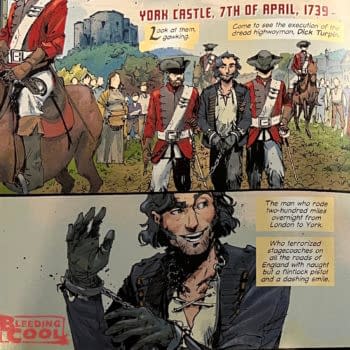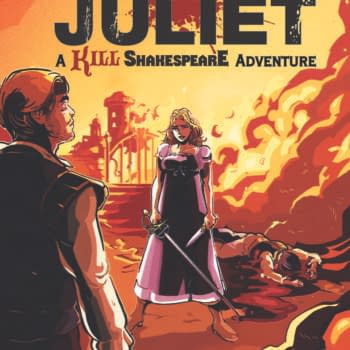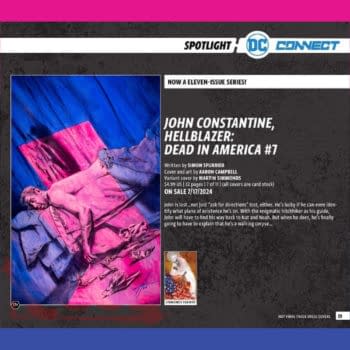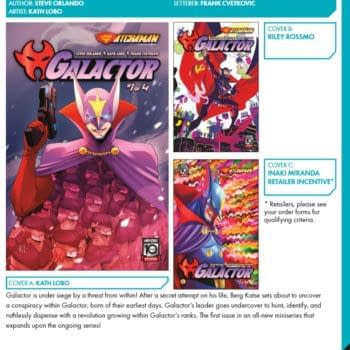Posted in: Comics, Recent Updates | Tagged: Comics, entertainment, kickstarter
I'll Buy That For $1 – Expanding An Ungrounded Universe On Kickstarter
By Patrick Gerard
Kickstarter is an internet "crowdfunding" platform which allows people to pre-pay for the creation of artistic and technological projects. The websites founders insist that it is not a store but rather a fundraising platform in which goods, services, and absurd favors can be bartered in exchange for help in making these creative projects happen. The platform has an all-or-nothing funding platform in which projects which hit their funding target in campaign backer pledges receive funding as backers' credit cards get charged for pledges and projects without sufficient pledges get nothing and no one is charged, although project creators are encouraged to try again with revised goals.
I personally have run several Kickstarter campaigns with more successes than failures, largely focused on my book Ungrounded, which features a scientist super-hero empowered by the Egyptian god Thoth and a flying polar bear named Ulysses. It artwork by Transformers Collectors Club's Eryck Webb and has had contributions by Art Thibert, Secret Wars tie-in E for Extinction's Dennis Culver, and Jim Ritchey, an artist who drew one of the "Miracleman" stories Marvel is unlikely to ever reprint in its collections: the Total Eclipse crossover that paired Miracleman with the Adolescent Radioactive Black Belt Hamsters. The latest volume of my book in production, Ungrounded: The First Revolution, features all of the material produced so far and some guest artwork by Imaginary Drugs' John Derrick West and Gladstone's School for World Conquerors' Armand Villavert, as well as stories by industry vets Brian Augustyn and Tom Peyer. The book features a cover by Eryck Webb and World of Warcraft's Tony Washington. Those curious can check out the campaign to expand the book's special features which is on Kickstarter now through Friday, August 28th. It had a funding goal of $1 and is cruising towards its first stretch goal as of the writing of this article.
Kickstarter has been a platform for many indie and not-so-indie comic book projects, including campaigns by several Image Comics books released by Top Cow, Brandon Montclare and Amy Reeder's Rocket Girl, Rob Liefeld's delayed Brigade relaunch (Liefeld cites issues with colorists), Art Thibert's Chrono Mechanics, a number of books later picked up by Action Lab and IDW, and even a campaign by Archie Comics, which vanished from the site amidst some controversy. The big winners on the site's comics section are often big name comic book creators such as Gail Simone, Bryan Q. Miller, Jamal Igle,and the team of Art Baltezar and Franco. These creators launched campaigns for creator owned books hot on the heels of high profile cancellations of cult favorite comics and raised tens of thousands of dollars. Some legendary creators such as John Ostrander and Tom Mandrake, Jimmy Palmiotti, Steve Rude, and Steve Ditko have also funded creator-owned books on the site.
While Kickstarter requires that a project hit its funding goal to get any money at all from backers, its rival crowdfunding operation Indiegogo has "flexible funding", allowing campaigns that fall short to still charge campaign backers and proceed if they choose to. DC Comics has used Indiegogo for several charity campaigns. Both sites allow campaigns to raise far more than what they initially ask for and a trend among project creators has emerged of "stretch goals", which promise ways to spend excess money raised.
The creators of the web comic Penny Arcade raised eyebrows — and the ire of some — in May of 2013 when they launched a crowdfunding campaign on Kickstarter to fund a podcast for a goal of $10 and proceeded to expand that with larger-than-life stretch goals (ie. higher funding targets for additional goals) for tens of thousands of dollars. Likewise, Sullivans Sluggers writer Mark Andrew Smith achieved a degree of notoriety that persists on Twitter for launching a Kickstarter campaign to pursue additional funding for the international shipping of that comic in a campaign whose funding started at $1. While Penny Arcade's Kickstarter went on to raise over $200,000, Smith's campaign was suspended by the website for reasons that were never made entirely clear, although some believed the $1 funding goal was seen as a circumvention of Kickstarter's rules. Both Smith and Penny Arcade's Kickstarters were roundly criticized for seeking low goals.
On the other side of the spectrum, James Fristrom, the Spider-man 2 designer who invented that video game's web-slinging system, was greeted much more favorably with his Kickstarter campaign for the game Energy Hook which fully funded for $1, under the theory that he intended to complete it anyway regardless of funding but that the funding would speed up his production. That campaign raised $41,535.
Neil Gaiman's famous rock star wife Amanda Palmer had a popular Kickstarter campaign which raised over a million dollars for a tour after asking for just $100,000. Controversy surrounded how she chose to spend the surplus and the campaign's saga helped inspire her book The Art of Asking, along with insights from her former career as a living statue street performer.
The reality is that excess funding does not always equal excess profit for people who run Kickstarter campaigns. The obvious scaling expenses are higher income taxes paid by project creators when they raise more and unanticipated shipping expenses (a problem made worse potentially by Kickstarter counting extra fees incurred for international shipping towards funding goals which are typically set with fixed expenses like large printing runs in mind). The less obvious expenses are often variable costs. My own book Ungrounded: The First Revolution is still at a relatively low order threshold where I am going to be ordering copies almost exactly to campaign backer demand. It's partly because so many of my expenses are variable at this point that I felt I could set my target funding goal at $1 for the new campaign, which is funding profile pages in the style of The Official Handbook of The Marvel Universe and DC Comics' Who's Who in the DC Universe. I added three pages to the book for that initial $1 and the campaign's stretch goals will add roughly 70 pages total to the book's length. In fact, I had considered making the guidebook to my book's roughly 70 original characters (such as the vampire-werewolf-zombie Major Freakshow or Odysseus the Mecha-Penguin) into a separate book. It was only after crunching numbers that I realized that I could provide a superior value to people anticipating the book's release by bundling the expanded guidebook into the trade collection, which is what the new campaign is financing.
Part of where Mark Andrew Smith's Sullivan's Sluggers campaign raised some eyebrows was that he was using his second Kickstarter to sell off inventory from a print run in the thousands before the original international backers of his first campaign received copies. More than likely, his campaign was suspended because it wasn't targeted at creating anything new and because of controversies over paying for a budget shortfall with a new campaign. The book did go on to some fantastic reviews (especially for the art work by artist James Stokoe and the book's fun premise). Many of the other $1 campaigns raised eyebrows for raising money for already wealthy people, such as the Penny Arcade creators.
In my case, I am not wealthy by any stretch (although I have nothing against Zach Braff, Spike Lee, or Rob Thomas running Kickstarter campaigns; I think it's a great way to measure demand for a project) and I couldn't afford any of this without a platform like Kickstarter. The platform has really made some impossible dreams almost attainable although I've always ended up covering some extra expenses out of pocket to make the comics shine. I am also really passionate about the new material we're trying to make with this campaign and the one we launched earlier this year. Working with Tom Peyer and Brian Augustyn in particular has been a dream of mine for years and seeing the artwork on the core book approach completion is a thrill. Tom has some crazy new characters for the book that are like a cross between the Fantastic Four and scripted cable drama archetypes found in Mad Men, Dexter, and Breaking Bad. Brian created a whole mini-universe of characters for his story. And I'm getting really excited to see color work come in on one of my new stories in the volume. I doubt anyone who reads it will soon forget the Flamingo Fuhrer's hot pink I.R.O.N. Parrot Legion.
I hope you choose to stop by the campaign and help us out. Setting a $1 funding goal is a big risk. Because backers can pull out up to the entire funding goal of the book in the last 48 hours (and everything prior to that), a lower goal is a bigger risk for project creators. It can also hinder momentum for a campaign. Still, $1 entitles you to say that you were responsible for 100% of the funding of a Kickstarter and will get you the first digital chapter of the book. We also have some cool embroidered ball caps left as early bird specials at a reduced asking price. For the discerning backer, we even have original artwork by Art Thibert and a sketch cover edition with work by Tim Sale.
Upgrading "Ungrounded: The First Revolution" runs through August 28th 2015 on Kickstarter.
















